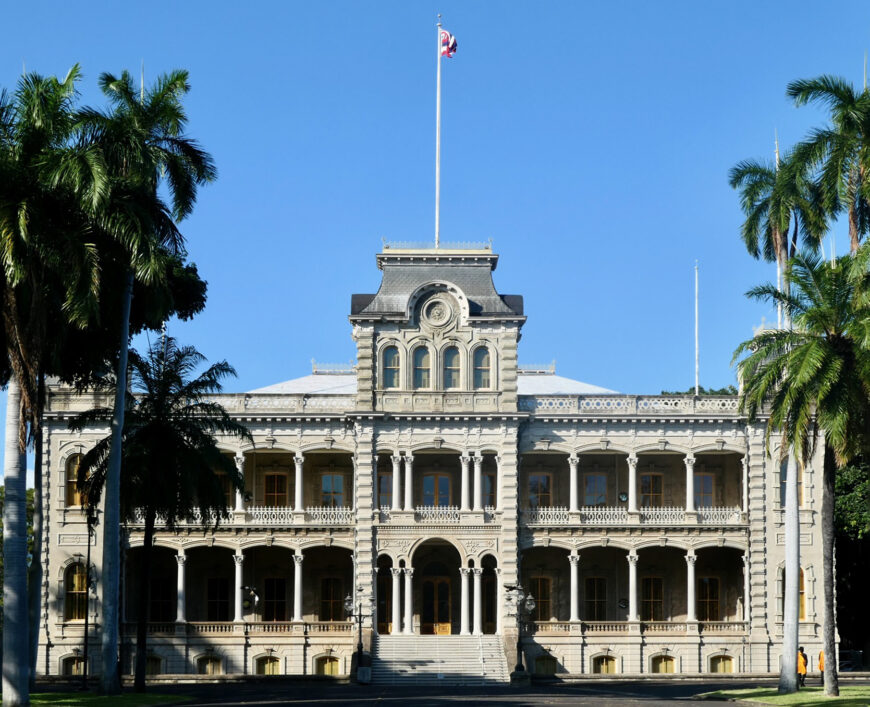
ʻIolani Palace, Honolulu, Oʻahu, Hawaiʻi, built 1879–82, photographed 2024, plastered brick and iron with concrete (photo: Stacy L. Kamehiro, CC BY-NC-SA 4.0)
An emblem of Hawaiian history and national sovereignty, ʻIolani Palace has been an important fixture in the political and cultural landscape of Hawaiʻi. The palace served as the monarchical seat from 1883–93 during the reigns of King David Kalākaua and his successor Queen Liliʻuokalani. It later functioned as the legislative halls and executive offices for the white-led provisional government that overthrew the Kānaka ʻŌiwi (Native Hawaiian) monarchy in 1893 and established the Republic of Hawaiʻi in 1894. The structure continued as the administrative building of the Territory of Hawaiʻi upon annexation by the United States in 1898. When Hawaiʻi became the fiftieth American state in 1959, ʻIolani Palace remained the political center until the new State Capitol Building was erected nearby in 1969. In the 1970s, the palace was restored and opened to the public as a historic house museum. The building persists as a key symbol of Kānaka ʻŌiwi history and culture—the center of sovereignty movements and commemorations of Hawaiian royalty.
The palace exemplifies the relationships between Indigenous agency and global dynamics in the shaping of visual and spatial forms that imagined the future of the Hawaiian Kingdom in the late 19th century. Through the functions and purposeful location of his palace, as well as its design, embellishment, and technological innovations, King Kalākaua projected his vision of himself as both an internationally recognized ruler and an exalted political and religious authority in Indigenous terms. [1]

ʻIolani Palace, Honolulu, Oʻahu, Hawaiʻi, built 1879–82, photographed c. 1880s, plastered brick and iron with concrete (Hawaiʻi State Archives, Honolulu)
ʻIolani Palace as national and international symbol
Built of plastered brick and iron with concrete block trimmings, ʻIolani Palace is a heavy rectangular structure (ground plan, 120 x 140 feet) of two main stories plus attic and basement levels. Four towers, each approximately sixty feet high, flank the deep verandas that encircle the colonnaded second and third stories, and towers eighty feet high rise above the front and rear entrances. A six-foot-wide trench resembling a moat encloses the bottom floor, providing the basement with light and air.
King Kalākaua and his supporters considered the palace of utmost national importance and worthy of great expenditure. It was, in part, intended to celebrate the success of the prospering Hawaiian nation and convey its modernity and cosmopolitanism to international observers. Kalākaua celebrated the accomplishments of his kingdom through the ostentatious palace and the extravagant display of expensive decorations and interior fittings. Its profusion of gold leaf, expensive fabrics, fine china, polished woods, and gifts from King Rama V of Siam (Thailand), Queen Victoria, Napoleon III, and other rulers contributed to this effect.
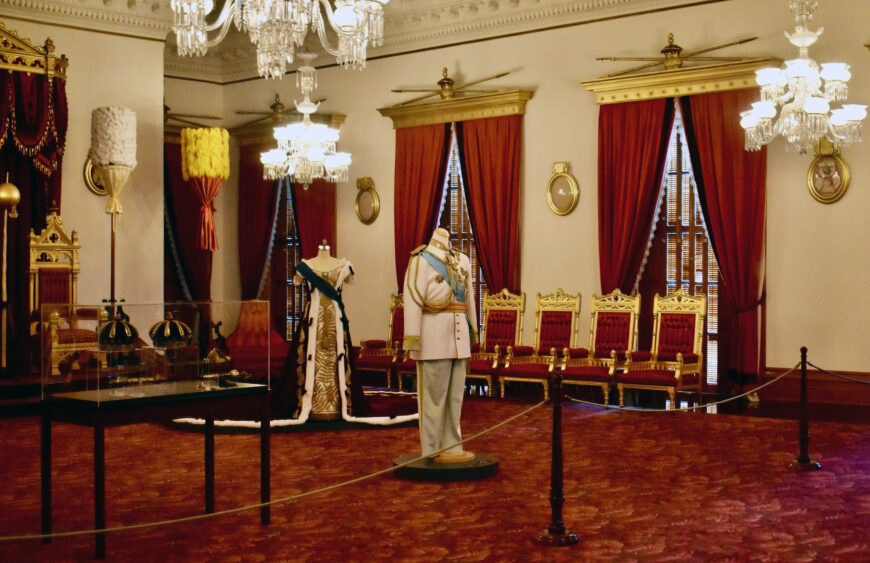
The Throne Room of ʻIolani Palace in 2022. The photograph shows some of the Hawaiian and foreign royal orders in oval gilt frames as well as some of the original palace furnishings and examples of King Kalākaua’s and Queen Kapiʻolani’s wardrobes (photo: Stacy L. Kamehiro, CC BY-NC-SA 4.0)
Adding to the palace’s global character was the inclusion of foreign royal orders. The state heads of Japan, Austria, Sweden, Norway, Denmark, Spain, Italy, Venezuela, Great Britain, Belgium, Germany, Portugal, Thailand, and many other nations bestowed these signs of respect and friendship on Kalākaua. [2] Insignia and ribbons comprising the foreign orders were mounted on escutcheons in gilt frames on the walls of the Throne Room, displayed with the Hawaiian Royal Orders to indicate equal sovereignty.
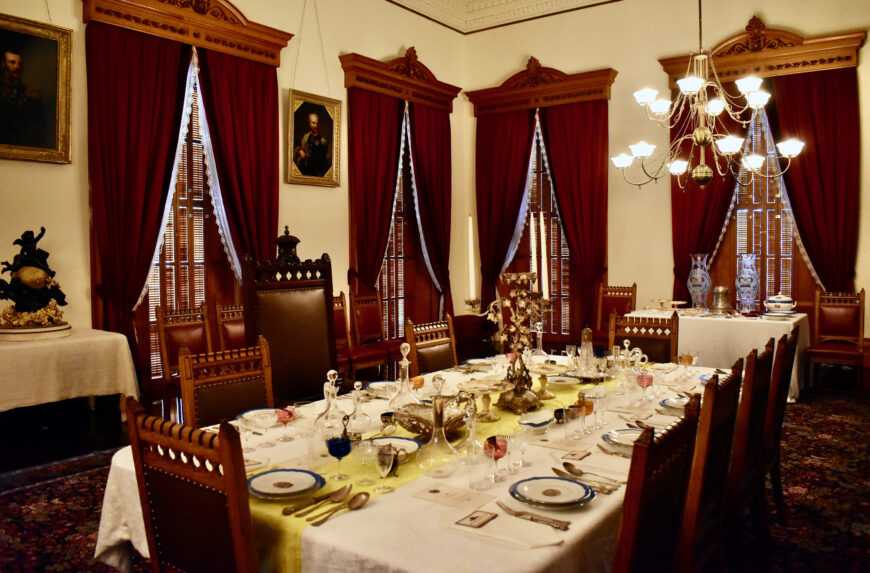
The State Dining Room of ʻIolani Palace in 2022. Two of the portraits of European rulers are visible on left wall (photo: Stacy L. Kamehiro, CC BY-NC-SA 4.0)
Similarly, portraits of rulers and notable individuals from foreign countries—such as Rear Admiral Richard D. Thomas, Lord Beaconsfield, and William Gladstone of Great Britain; Alexander II of Russia; Napoleon III and Louis Philippe of France; and Frederick William III of Prussia adorned the palace walls, along with portraits of Native Hawaiian royalty. [3] King Kalākaua’s combination of images of foreign leaders and those of his family and chiefly predecessors worked to establish him as an equal and legitimate member of the international ruling community.
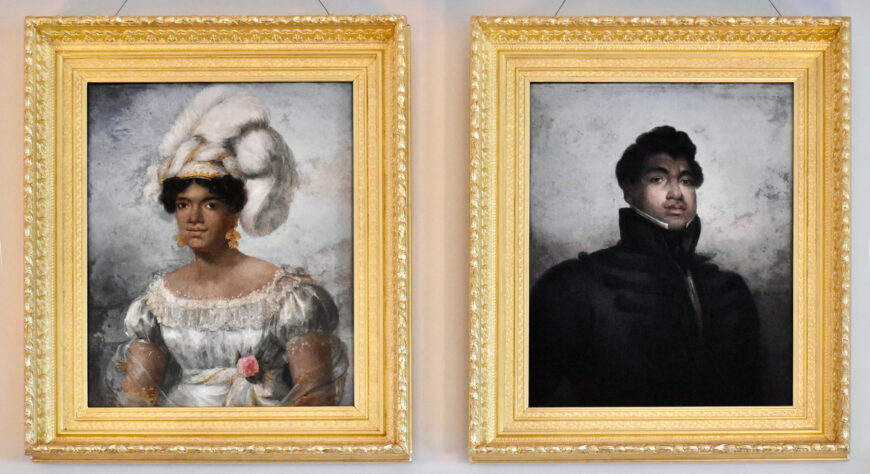
Two of the royal Hawaiian portraits hanging in the Grand Hall of ʻIolani Palace. On the left is a portrait of Queen Kamāmalu, spouse of King Kamehameha II, attributed to John Hayter and made while she was visiting London in 1824. The king’s portrait, on the right, was painted by Eugene Le Brun in 1826 after drawings by John Hayter (photo: Stacy L. Kamehiro, CC BY-NC-SA 4.0)
Kalākaua also incorporated technical innovations and modern inventions such as the use of concrete blocks (which was fairly new to masons throughout the world), sheet glass, a telephone system (the first in Honolulu), modern indoor plumbing, and electric lighting (ʻIolani Palace had electricity before the White House or Buckingham Palace). Garnering favorable attention in the international press, the palace proved its place as a political center in a modern city and modern state, indicating its future in the world order and making the Hawaiian nation visible to all.

Hale ʻĀkala, on the ʻIolani Palace grounds, c. 1880s. The roofline is trimmed with pūloʻuloʻu. Kalākaua and Kapiʻolani are standing to the right (Hawaiʻi State Archives, Honolulu)
Chiefly structures and sacred spaces
While the palace could boast of its international style, urbane furnishings, and modern fabrication, it nonetheless was a Hawaiian chiefly structure. The palace compound resembled a kauhale, a chiefly building complex often surrounded by a fence or wall. In addition to the homes of chiefs and retainers, kauhale included buildings with specialized functions: temples, separate men’s and women’s eating houses, sleeping houses, work structures, etc. The ʻIolani building complex was similarly comprised of multiple buildings enclosed by a high wall. One of the buildings, named Hale ʻĀkala, assumed the function of a traditional sleeping house, and provided the king and his queen, Kapiʻolani, with a comfortable private residence. [4]
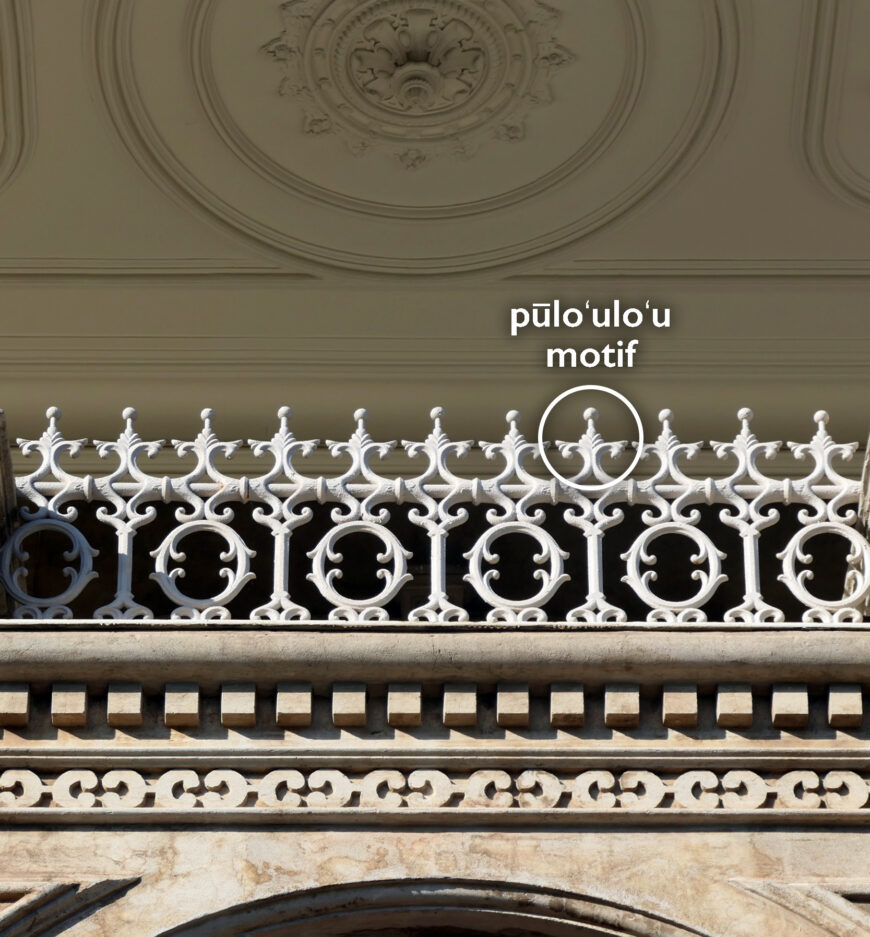
Pūloʻuloʻu motifs on the second story veranda railings, ʻIolani Palace, photographed 2024 (photo: Stacy L. Kamehiro, CC BY-NC-SA 4.0)
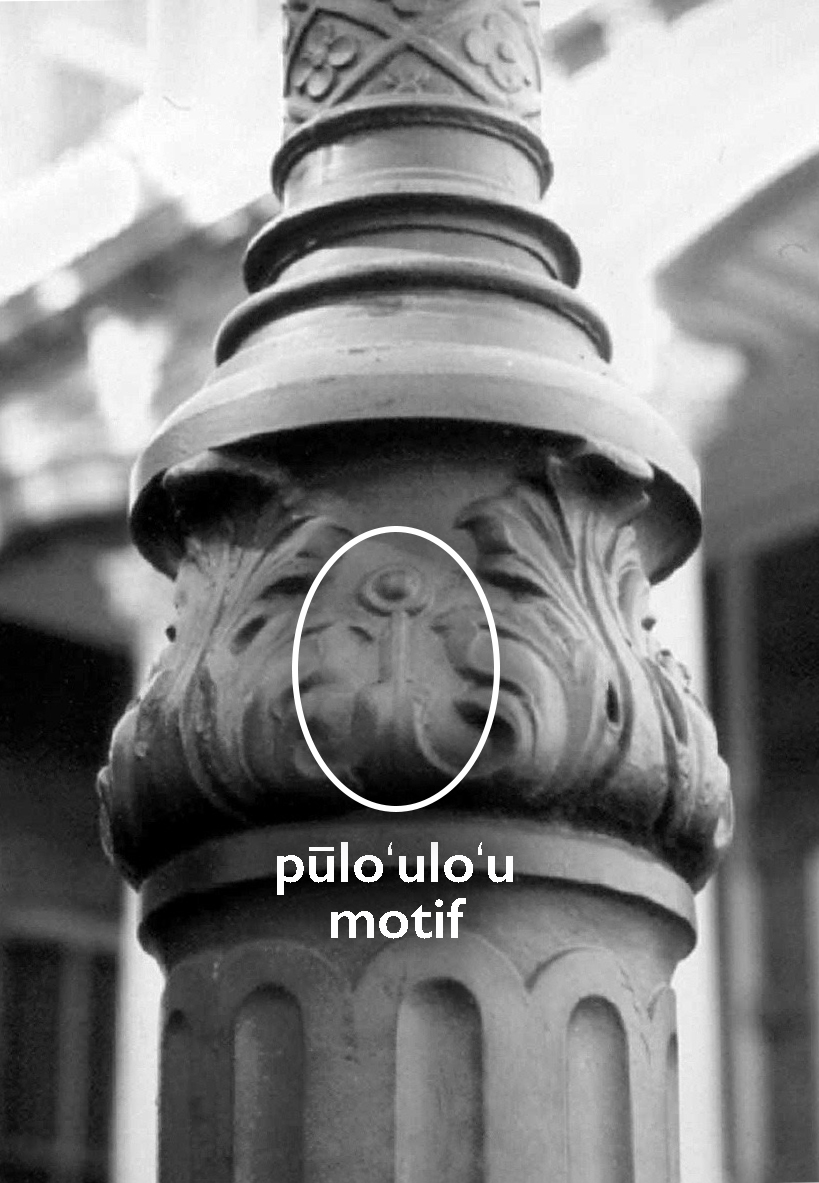
Iron lamppost cast with pūloʻuloʻu motifs (detail), ʻIolani Palace, photographed 2021 (photo: Stacy L. Kamehiro, CC BY-NC-SA 4.0)
The palace building itself adapted some of the roles of both the men’s eating house (hale mua) and temple (heiau) found in earlier kauhale. The size of a hale mua indicated a chief’s rank and served as an audience chamber and a space where men prepared and ate their foods. Markers called pūloʻuloʻu—sticks or spears surmounted by a cloth-covered ball that warned passersby against trespass—distinguished the hale mua as a sacred (kapu) space. Like an eating house, ʻIolani Palace’s considerable size and the rows of pūloʻuloʻu capping the second story veranda railings, which were designed by King Kalākaua, designated the restricted and sacred nature of the building, intended for formal audiences and official functions. Kalākaua added more pūloʻuloʻu in the form of cast-iron lampposts flanking the front and rear entrances to the palace (see top image for full view of lampposts). Each topped by three glass globes, the lamps resemble pūloʻuloʻu and have pūloʻuloʻu motifs cast around their shafts. Large spheres crowning the gateway posts in the walls of the ʻIolani compound extended these kapu symbols to the limits of the palace grounds. These multiple markers of kapu space visually and spatially insisted on the king’s sacred rank and privilege.
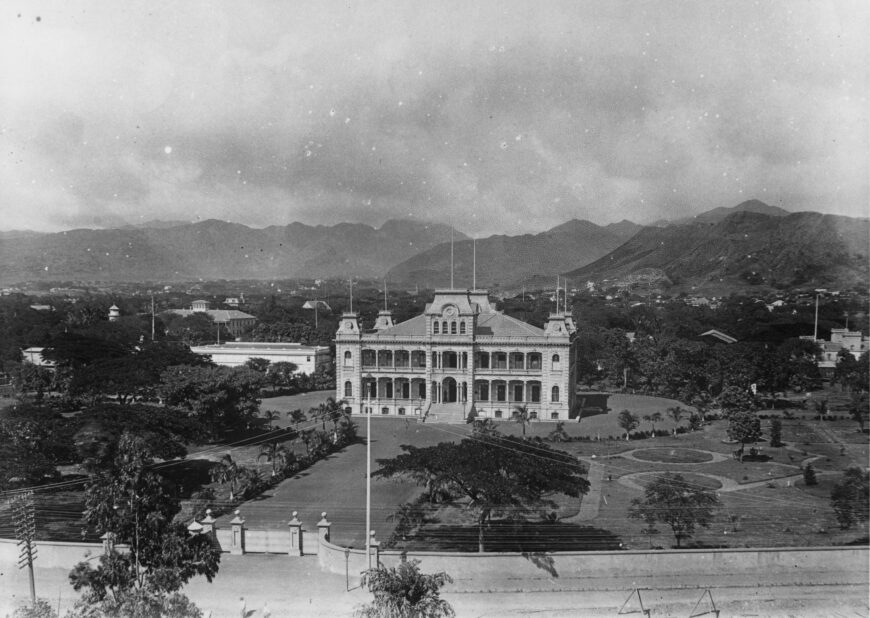
ʻIolani Palace in the mid-1880s. Hale ʻĀkala is located in the background left and the ʻIolani Palace Barracks can be seen to the right in the distance. The compound was contained by an eight-foot-high plastered coral block wall. The spherical caps on the gateway posts resemble large pūloʻuloʻu (State Archives of Hawaiʻi, Honolulu)
The main palace building also took on the character of a temple (heiau). The way it was oriented between the mountains and the ocean and its location on and near the site of several important early heiau correspond to the customary planning of certain high-level temple structures. ʻIolani Palace’s directional orientation along a northeast–southwest axis also suggests it was a modern translation of a heiau. Noted archaeologist Patrick Kirch posits an interpretation of heiau orientation, especially facing east, north, and east-northeast, that accords with the reckoning of time, the rising and setting of the sun, and major Hawaiian deities. [5]
Traditionally, Hawaiian paramount chiefs were trained ritual specialists who were required to perform the necessary temple rites securing the productivity of the land and people. Chiefs were the intermediaries between people and the gods, and the welfare of all depended on them. Kalākaua himself was a recognized priest (kahuna), known for reviving Indigenous religious practices, which were in decline due to the impact of Christian missions. In erecting ʻIolani Palace as a temple linked to sacred sites, Kalākaua continued the practice of building sacred structures for the chiefdom’s (the nation’s) welfare.
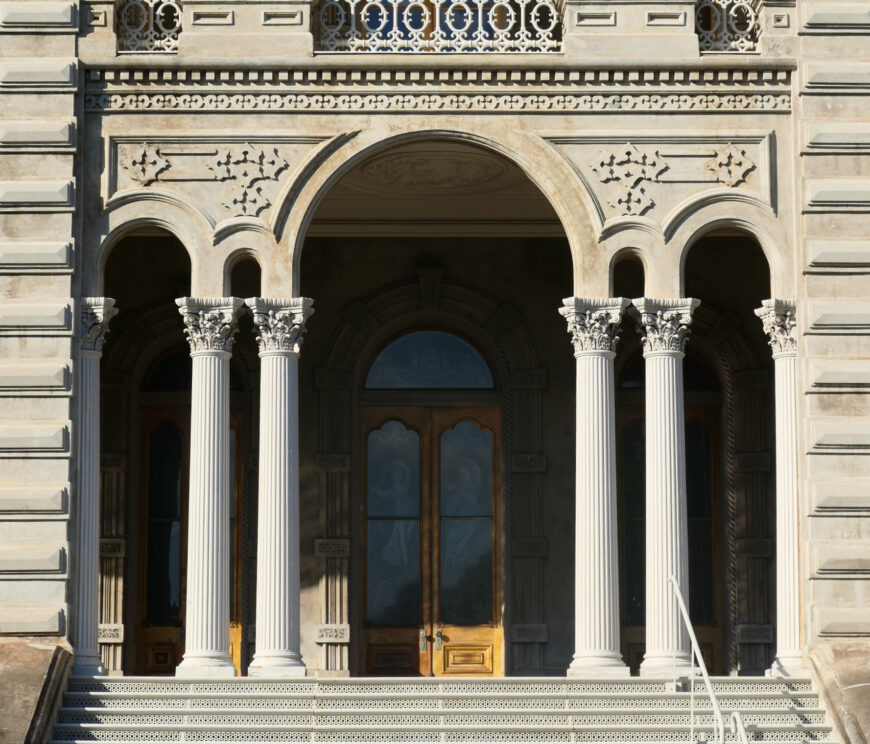
Arched (hoaka) vestibule and entrance of ʻIolani Palace in 2024 (photo: Stacy L. Kamehiro, CC BY-NC-SA 4.0)
Other architectural elements portrayed the king as a sacred chief. Like the post-and-arch doors of traditional chiefly homes, the palace’s entrance vestibules consisted of columns capped with arches, flanked by two additional smaller arches. The arched form was called “hoaka” and was intimately associated with chiefs; it denoted “brightness” and “splendor” in Kānaka ʻŌiwi verbal and visual language, offering a poetic metaphor for the revered and divine genealogy of chiefs. Hoaka figured prominently in other visual forms connected with chiefs, such as feather cloaks and helmets, finely decorated barkcloths temple drums, and sculpture. Given the nativist and nationalist sentiments evoked by the palace, it is not surprising that a 19th-century Hawaiian dictionary supplied this additional translation of hoaka: “Glory, as of a people, i.e., their liberty; freedom.” [6]
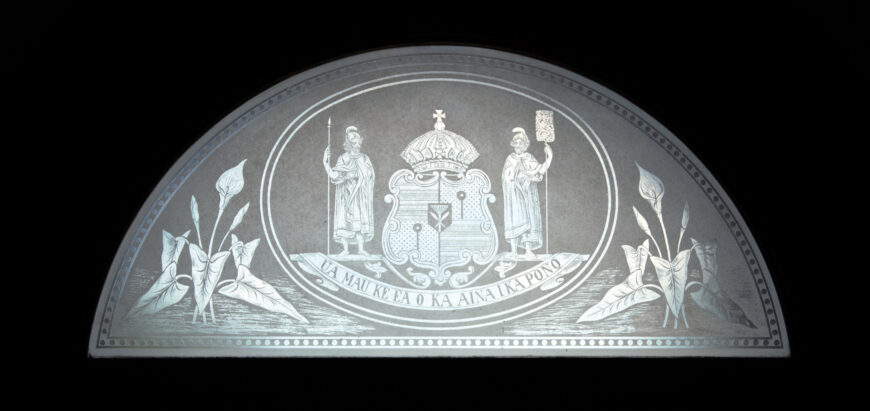
Central transom window, entry door to the Grand Hall of ʻIolani Palace (photo: courtesy of The Friends of ʻIolani Palace)
The imagery in the etched sheet-crystal transom windows of the front and rear portals echoed conceptions of the king as the foundation of a thriving existence. Clusters of kalo (taro) leaves, a key staple in the Hawaiian diet and kin to Kānaka ‘Oiwi, flank the kingdom’s coat of arms. The kalo leaves reference the chief as the source and guardian of life. The scroll at the bottom of the coat of arms bears the national motto, “Ua mau ke ea o ka aina i ka pono” (“The life of the land is perpetuated in righteousness”), emphasizing the “rightness” or “righteousness” (pono) of Hawaiʻi’s rulers to maintain the life and sovereignty (ea) of the land and nation (ʻāina). The taro motif and coat of arms are surmounted by an arch, hoaka; they are meaningfully juxtaposed, together formalizing the chief’s divine ancestry (hoaka) and proper leadership necessary to maintain the prosperity of the land and people (taro).
The palace symbolized the sacred rule founded in deep history, as attested to by the structure’s placement among ancient temple sites and its cosmic geographical orientation, and also marked a critical juncture in projecting the future of the kingdom in the context of 19th-century colonial pressures. Its Euro-American form and technological innovations and the very existence of the building testified to Hawaiʻi’s modernity, but in Indigenous terms. ʻIolani Palace could dazzle international audiences, as well as resonate with the hopes and values of the Kānaka ʻŌiwi population. It was an authentically modern and traditional Hawaiian symbol of the state of the nation that spoke to its future.


